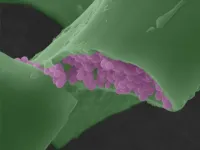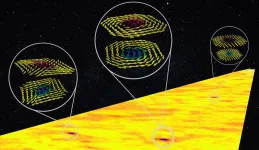Fossil pigments shed new light on vertebrate evolution
UCC palaeontologists have discovered new evidence that the fate of vertebrate animals over the last 400 million years has been shaped by microscopic melanin pigments.
2021-02-04
(Press-News.org) UCC palaeontologists have discovered new evidence that the fate of vertebrate animals over the last 400 million years has been shaped by microscopic melanin pigments.
This new twist in the story of animal evolution is based on cutting-edge analyses of melanin granules - melanosomes - in many different fossil and modern vertebrates, including fish, amphibians, reptiles, birds and mammals. Melanin and melanosomes have traditionally been linked to outermost body tissues such as skin, hair and feathers, with important roles in UV protection and stiffening of tissues. Analyses of where different animals store melanin in the body, however, show that different vertebrate groups concentrate melanin in different organs, revealing shifts in how animals have used melanin over the last 400 million years.
The study, published today in the journal Trends in Ecology and Evolution, was led by UCC palaeontologists Prof. Maria McNamara, Dr Chris Rogers, Dr Valentina Rossi and PhD student Tiffany Slater, with an international team of evolutionary biologists from Switzerland.
"Most studies of fossil melanin have focussed on melanin in fossil feathers and skin, and what colours ancient animals had," said study leader Prof. McNamara. "By comparing melanin in different animals - how much melanin they have, where in the body it occurs, what melanin type and composition is present - and by studying fossils, we discovered new evidence for changes in the functions of melanin through deep time."
The research shows that amphibians and reptiles concentrate melanin in internal organs, where it supports the immune system and stores metals. In birds and mammals, however, almost all melanin occurs in hair and feathers. This difference has an unexpected source - evolution of the immune system and of warm-blooded lifestyles.
"There are pros and cons to having melanin in the body," said team member Dr Rossi. "Melanin is hugely beneficial, but it also generates free radicals, which are harmful. This creates a major problem for animals."
During the evolution of hair and feathers, mammals and birds evolved more sophisticated immune systems than in amphibians and reptiles. This meant that large amounts of melanin were no longer necessary in internal organs. Melanin storage then shifted to hair and feathers, which are dead tissues, thereby removing harmful metals and free radicals from living body parts.
"Melanin is a two-sided coin," said Prof. McNamara. "It's useful, but toxic. Birds and mammals basically came up with an ingenious solution during the early Triassic - pump melanin into new, outer, dead skin tissues that were evolving at the time. This set the scene for the evolution of the incredible diversity of plumage and fur patterning which we see today."
The study also shows that key genes can be mapped onto colour patterns in fossils, tracking the genetic evolution of melanin through time, and that animals preferentially use less toxic forms of melanin. "There's still a lot about melanin genetics and physiology that we don't understand," said Dr Ducrest of Lausanne University. What's clear, however, is that the fossil record is a valuable source of information that we can use going forwards."
INFORMATION:
[Attachments] See images for this press release:

ELSE PRESS RELEASES FROM THIS DATE:
2021-02-04
Ultrasound is not only used as an imaging technique but targeted pulses of ultrasound can be used as a highly accurate treatment for a range of brain diseases, for which there were previously only limited treatment options. Over the last few years, several revolutionary techniques of this kind have been developed, primarily in Toronto but also at MedUni Vienna. The Viennese technique improves brain functions by externally activating neurons that are still functional. Improvements can be expected in various neuropsychiatric brain diseases such as Alzheimer's, Parkinson's, stroke, Multiple Sclerosis, and neuralgia. A review jointly written by ...
2021-02-04
Researchers at NUI Galway have identified genomic signatures in women developing the most common type of breast cancer that can be associated with long-term survival. The NUI Galway team analysed the genomes of breast cancer patients to look for associations with survival rates using advanced statistical techniques.
Carried out by Lydia King during her studies in NUI Galway's MSc in Biomedical Genomics programme, the research has been published in the international journal PLOS ONE.
Early detection by national screening programmes and timely treatment for patients diagnosed with "luminal" types of breast cancer have resulted in excellent prognoses with survival rates of over 80% within five years of treatment. The challenge of long-term survival ...
2021-02-04
FOOD SCIENCE Sweden takes first, Denmark second and Norway lags at the bottom when it comes to how much organic food is served in canteens, kindergartens and other public sector workplaces across the three Nordic nations. This, according to the results of a new report by the University of Copenhagen. The report details plenty of potential for expanding the conversion to organic food service in the Danish public sector--a topic of discussion across the EU at the moment.
Plate with potatoes and beef
The governments of Denmark, Norway and Sweden are all keen on ramping up the amount of organic food ...
2021-02-04
The FinnBrain research of the University of Turku has demonstrated for the first time that the stress the father has experienced in his childhood is connected to the development of the white matter tracts in the child's brain. Whether this connection is transmitted through epigenetic inheritance needs further research.
Evidence from multiple new animal studies demonstrates that the changes in gene function caused by environment can be inherited between generations through gametes. In particular, nutrition and stress have been proven to cause these types of changes. However, these do not alter the nucleic acid sequence of ...
2021-02-04
Today's digital world generates vast amounts of data every second. Hence, there is a need for memory chips that can store more data in less space, as well as the ability to read and write that data faster while using less energy.
Researchers from the National University of Singapore (NUS), working with collaborators from the University of Oxford, Diamond Light Source (the United Kingdom's national synchrotron science facility) and University of Wisconsin Madison, have now developed an ultra-thin material with unique properties that could eventually achieve some of these goals. Their ...
2021-02-04
A study published in the journal Pediatrics expands validation evidence for a new screening tool that directly engages preschool-age children during clinic visits to assess their early literacy skills. The tool, which is the first of its kind, has the potential to identify reading difficulties as early as possible, target interventions and empower families to help their child at home, according to researchers at Cincinnati Children's Hospital Medical Center.
The Reading House (TRH) is an assessment for ages 3-5 based on a specially designed children's book, which was developed by John Hutton, MD, and his team at Cincinnati Children's. Screening takes five minutes and gauges performance levels ...
2021-02-04
An inexpensive, long-lasting and easy-to-administer vaccine against malaria could be a game-changer for millions of people living in countries where the mosquito-borne disease is endemic.
Lucie Jelinkova, a graduate student in the laboratory of Bryce Chackerian, PhD, professor in The University of New Mexico Department of Molecular Genetics & Microbiology, has identified a method that could make that dream into reality.
In research recently published in the journal NPJ Vaccines, Jelinkova and colleagues at Johns Hopkins and Flinders University in Australia report ...
2021-02-04
Tuberous sclerosis complex (TSC) afflicts as many as two million people around the world, affecting multiple organs, including lungs, brain, skin and kidneys. In about 80 percent of cases, it causes cysts and benign tumors to form in the kidney, eventually resulting in kidney failure.
It's known that the disease is triggered by genetic mutations, but how these mutations lead to the formation of kidney cysts has been poorly understood - until now.
Nephrologist Manoocher Soleimani, MD, a professor in The University of New Mexico Department of Internal Medicine, led a team that solved the puzzle and pointed the way toward potential ...
2021-02-04
Twitter has long provided a short, sharp take on the community's fears, anxieties and experiences. Now, data scientists have analysed 94 million tweets from the first months of the pandemic to track COVID-19's effect on mental health in NSW.
The research team used machine learning to develop a model able to capture data indicating depression, stress, anxiety and suicidal thoughts among users of the social media platform.
The aim was to tap into popular technology to help public health experts identify changes in community levels of depression over time.
The World Health Organisation highlighted early in 2020 that the pandemic would likely have a negative impact on mental health, with the disease affecting many facets of life including work, health and relationships.
Researchers from ...
2021-02-04
Senescent cells accumulate in organs during aging, promote tissue dysfunction, and cause numerous aging-related diseases like cancer. The cells arise through a process called "cellular senescence," a permanent cell cycle arrest resulting from multiple stresses.
A collaborative research group led by Professor Makoto Nakanishi of the Institute of Medical Science, The University of Tokyo (IMSUT), and co-researchers has identified an inhibitor of the glutamate metabolic enzyme GLS1(*1) so that its administration selectively eliminates senescent cells in vivo. They confirmed that the GLS1 inhibitor eliminated senescent cells from various organs and tissues in aged mice, ameliorating age-associated tissue dysfunction and the symptoms of obese diabetes, arteriosclerosis, and ...
LAST 30 PRESS RELEASES:
[Press-News.org] Fossil pigments shed new light on vertebrate evolution
UCC palaeontologists have discovered new evidence that the fate of vertebrate animals over the last 400 million years has been shaped by microscopic melanin pigments.




